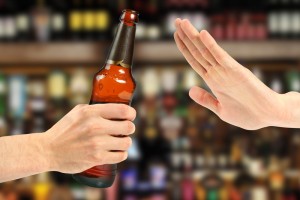
In those with post-traumatic stress disorder (PTSD), alcohol abuse or dependence is the most common co-morbid disorder.
Unfortunately, although individuals with PTSD and alcohol dependence (AD) often have complex needs, the treatments available usually only target one issue. This is often due to specialist treatment services not having access to treatments for comorbid disorders, and the belief that treatment for PTSD can increase drinking behaviour, while AD may interfere with PTSD treatment.
Following treatment, those with comorbid PTSD and AD are more likely to relapse, and relapse quickly, than patients with AD alone or AD with other comorbidities. These increased risks combined with the complex needs of this patient group make the development of effective concurrent treatments a priority.

Effective concurrent treatments combine two or more therapies for two or more conditions
Foa and colleagues conducted a trial (recently published in JAMA) which primarily assessed the effectiveness of combining an evidence-based pharmacotherapy for AD (naltrexone) with an evidence-based psychosocial treatment for PTSD (prolonged exposure therapy).
Overall they found that:
- Naltrexone decreased percentage of drinking days
- Prolonged exposure therapy did not decrease PTSD symptoms compared with other groups during treatment
- Prolonged exposure therapy did not worsen percentage drinking behaviour
Methods
165 patients were recruited from two clinical sites in Pennsylvania and required a diagnosis of AD (defined by: DSM-IV, >12 drinks per week, >4 drinks in one day over past 30 days) and PTSD (DSM-IV, ≥15 score on the PTSD symptom severity scale). Patients did not have any other substance dependence (except nicotine), psychiatric condition, or physical condition which could interfere with the treatments provided.
Patients were randomised to 1 of 4 conditions:
- Prolonged exposure therapy & naltrexone (100 mg/d)
- Prolonged exposure therapy & placebo
- Naltrexone (100 mg/d)
- Placebo
Treatments were started after outpatient detoxification, and lasted 6 months. Prolonged exposure therapy was administered once a week for 12 weeks and then once a fortnight for 12 weeks, and involved: imagining, processing, and discussing traumatic memories; listening to these sessions at home; in vivo exposure to safe situations.
In addition, all participants received 18 supportive counselling sessions with a nurse (administered on the same time frame as the exposure therapy).
Outcome measures were PTSD symptom severity, percentage of days drinking and alcohol craving.
Outcome measures were taken at baseline, during treatment, and up to 52 weeks follow-up.
Results
Of the 165 patients, 11-15 patients in each treatment group did not receive the intervention as randomised; 20-26 completed the 3 month follow-up, 19-30 completed the 6 month follow-up.
Alcohol dependence outcomes:

Naltrexone decreased the percentage of drinking days
- All patients reported a decrease in drinking during treatment, irrespective of which group they were in
- Following treatment, those on naltrexone reported fewer drinking days than those on placebo
- Craving was lower in those receiving naltrexone, supporting the suggestion that naltrexone’s therapeutic effect may be to reduce craving
- There was no effect of prolonged exposure therapy on drinking outcomes
PTSD outcomes:
- PTSD symptoms decreased during treatment, irrespective of treatment group
- Following treatment, there were no differences in PTSD symptoms across the different groups
- Further analysis found that 70% of patients in the Exposure + Naltrexone group had a low PTSD severity score (≤10) 6 months following treatment. This compared favourably with those in the Exposure + Placebo (55%), naltrexone (43.9%) and placebo (37.2%) groups
Conclusions

Patients receiving the prolonged exposure treatment only attended a third of the available sessions on average
The finding that prolonged exposure therapy was no better than supportive counselling as a treatment for PTSD is inconsistent with other evidence. The authors suggest that supportive counselling (which all patients received) may have masked specific effects of prolonged exposure, and this is something that needs to be controlled for in future research. However, the lack of a significant finding may also be due to poor adherence rates; patients only attended an average of 6/18 exposure sessions.
Importantly, the PTSD treatment did not exacerbate AD symptoms and, at 6 month follow-up, there was a lower alcohol relapse rate in those from the Exposure + Naltrexone group.
Sum-up
Given the low adherence rates to the prolonged exposure treatment, this study is unable to comment on the long-term effectiveness of the PTSD therapy. The complex needs of this patient group make it possible that those with comorbid disorders have difficulties in engaging and sticking with treatment regimes. Therefore, future research needs to focus on ways to improve treatment adherence.
The now somewhat out of date NICE guidance (NICE, 2005) suggests treating alcohol dependence before PTSD treatment starts (although in severe cases collaborative care may be appropriate). However, the current study found that treatments did not exacerbate comorbid symptoms. It is important that research continues to investigate the effectiveness of concurrent treatments in complex patient groups, and for health services to look at ways to deliver such treatments packages.
Links
Foa EB., et al. (2013) Concurrent naltrexone and prolonged exposure therapy for patients with comorbid alcohol dependence and PTSD: a randomized clinical trial. Journal of the American Medical Association 310(5): 488-495. [Abstract]
Jacobsen LK., et al (2001) Substance use disorders in patients with posttraumatic stress disorder: A review of the literature. American Journal of Psychiatry 158(8): 1184-1190
Post-traumatic stress disorder (PTSD). The management of PTSD in adults and children in primary and secondary care (PDF). NICE clinical guideline 26, March 2005.


Concurrent treatments may be effective in treating comorbid alcohol dependence and PTSD: In those with post-tr… http://t.co/wxpQRmoXRU
@AbiRose9 on concurrent naltrexone & prolonged exposure therapy for patients with comorbid alcohol dependence & PTSD http://t.co/X5AazlnPeg
Concurrent treatments may be effective in treating comorbid alcohol dependence and PTSD http://t.co/I363z6zpHD via @sharethis @mental_elf
RCT: Naltrexone decreased percentage of drinking days in people with PTSD and alcohol dependence http://t.co/X5AazlnPeg
My new @Mental_Elf blog on concurrent naltrexone & prolonged exposure therapy for alcohol dependence & PTSD http://t.co/4eBaY90mAh
Great blog post! @AbiRose9 discusses concurrent treatments for PTSD and alcohol dependence for @Mental_Elf http://t.co/pDctakcaai
RCT: Prolonged exposure therapy didn’t decrease PTSD symptoms in alcoholics compared w/ other groups during treatment http://t.co/X5AazlnPeg
@Mental_Elf interesting!
@Mental_Elf very good to see someone is doing research on those with addiction and mental health disorders, would like to see more.
Concurrent treatments may be effective in treating comorbid alcohol dependence and PTSD – The… http://t.co/CmiZN4aaBz
RCT: Prolonged exposure therapy didn’t worsen % drinking behaviour in people with PTSD & alcohol dependence http://t.co/X5AazlnPeg
In case you missed it: Concurrent treatments may be effective in treating comorbid alcohol dependence and PTSD http://t.co/X5AazlnPeg
Mental Elf: Concurrent treatments may be effective in treating comorbid alcohol dependence and PTSD http://t.co/g4r9D8MNR6